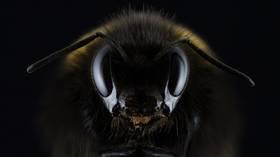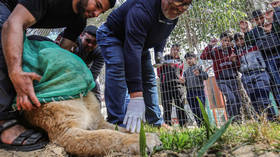Flying bulldog’? Researchers uncover GIANT BEE thought to be extinct for 3 decades (VIDEO)

The “holy grail of bees” has been discovered lurking in an Indonesian forest. Unseen by humans since 1981 and believed to be extinct, the thumb-length Wallace’s giant bee was finally spotted by a conservation group.
A Global Wildlife Conservation search team found and photographed Wallace’s giant bee (Megachile pluto) nesting in a termite mound in the forests of Ternate, an Indonesian island in the North Moluccas, in January. They had spent years researching where the ideal habitat for the long-lost creature – which co-discoverer and bee enthusiast Clay Bolt affectionately describes as a “flying bulldog” – might be.
WORLD’S LARGEST BEE: Take a look at Wallace’s Giant Bee!It’s the biggest bee in the world and hasn’t been seen in over 30 years ... until now. pic.twitter.com/KB1MjDBCdh
— CBSDenver (@CBSDenver) February 21, 2019
“My dream is to now use this rediscovery to elevate this bee to a symbol of conservation in this part of Indonesia, and a point of pride for the locals there,” Bolt said. Despite the bee’s prodigious size - or perhaps because of it - Wallace’s giant bee is not subject to any conservation measures.
As long as an adult thumb, with jaws like a stag beetle and four times larger than a honeybee, Wallace’s giant bee was feared extinct for 38 years, but now the world’s largest bee has been rediscovered on the Indonesian islands of the North Moluccashttps://t.co/JN7reGslNVpic.twitter.com/HlUxkLiVhA
— Alfons López Tena #FBPE (@alfonslopeztena) February 21, 2019
Global Wildlife Conservation considers M. pluto to be the “holy grail” of bees, listing it on their 25 “most wanted species” in their Search for Lost Species program. Wallace’s is the world’s largest bee – and with a wingspan averaging 6.4cm and a length approximately that of the human thumb, most of us were probably quite content not to have seen or heard from one for nearly four decades.
We're proud to announce the rediscovery of Wallace's Giant Bee, last seen in 1981! https://t.co/FWCXQgYvjN via @BBCWorld@hbriggs
— Global Wildlife Conservation (@Global_Wildlife) February 21, 2019
Mercifully, they live largely alone in burrows inside termite mounds – can you imagine being chased by a swarm of these things?














